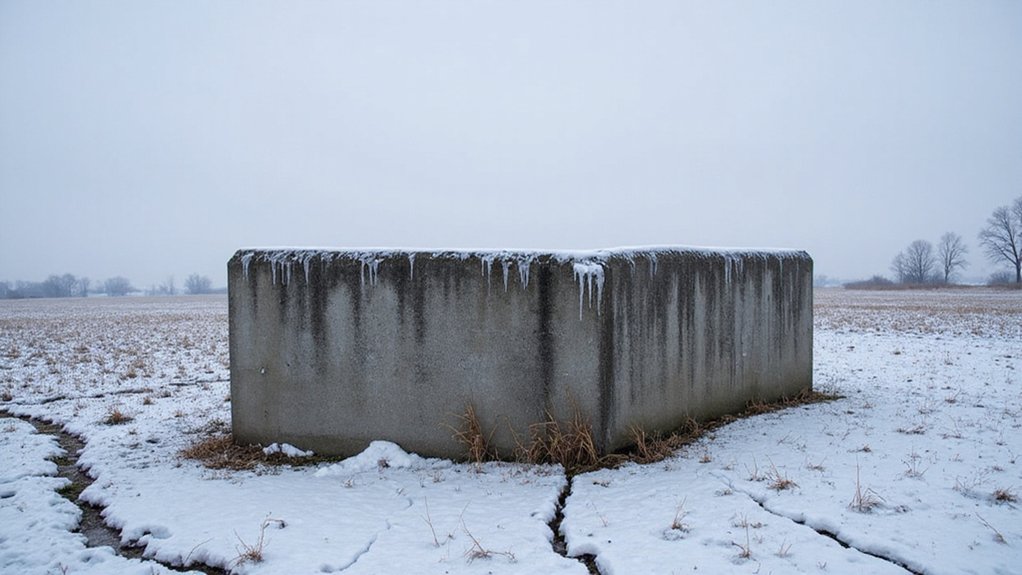As a homeowner in Northeast Ohio, you know all too well the impact that the region’s unpredictable weather can have on your concrete foundation. From drastic temperature swings to heavy snowfall and frequent precipitation, these environmental factors pose a constant threat to the structural integrity of your home. Understanding the challenges posed by this climate is the first step in safeguarding your investment and ensuring your family’s safety.
Temperature Fluctuations and Concrete Expansion
As a homeowner in Northeast Ohio, you’re likely all too familiar with the drastic temperature fluctuations that can occur throughout the year. These temperature swings can have a significant impact on your concrete foundation, causing it to expand and contract due to concrete thermal movement. The curing environment of your concrete can also impact its long-term durability and stability. Proper installation and maintenance are vital to safeguard your foundation remains strong and resilient, even in the face of Northeast Ohio’s unpredictable weather patterns. Comprehending the effects of temperature on concrete is the first step to shielding your home’s foundation. Basement waterproofing can also help mitigate the impact of soil shifting and aging on your foundation.
Heavy Snowfall and Foundation Stability
Northeast Ohio’s heavy snowfall doesn’t stop there. The accumulated snow can also put significant stress on your home’s foundation. Newly constructed homes experiencing some expected foundation settling can be particularly vulnerable. The immense snow load, combined with soil erosion, can cause your concrete foundation to crack, shift, or even collapse. This can lead to costly repairs and potentially compromise the structural integrity of your entire home.
Frequent Precipitation and Soil Saturation
Doesn’t the frequent precipitation in Northeast Ohio also contribute to foundation issues? The soil in the region is prone to moisture retention, which can lead to soil erosion and instability. This can have several consequences for your concrete foundation:
- Waterlogged soil puts additional pressure on the foundation, causing it to sink, crack, or tilt.
- Erosion weakens the soil around the foundation, compromising its support.
- Persistent moisture can seep into the concrete, leading to cracks, crumbling, and other structural damage.
Addressing these challenges is pivotal for maintaining the integrity of your home’s foundation.
Freeze-Thaw Cycles and Concrete Deterioration
Additionally, the freeze-thaw cycles prevalent in Northeast Ohio can wreak havoc on your concrete foundation. As the temperature drops, water in the soil expands when it freezes, creating hydrostatic pressure that can cause your foundation to crack.
When the weather warms up, the ice melts, and the soil can settle unevenly, leading to more concrete cracking patterns. This cycle of freezing and thawing can weaken your foundation over time, compromising its structural integrity. Addressing these freeze-thaw issues promptly can help protect your home and prevent costly repairs down the road.
Preventative Measures for Homeowners
Fortunately, there are several preventative measures you can take to protect your concrete foundation from the damaging effects of freeze-thaw cycles.
First, guarantee proper drainage planning around your home. This includes strategically placed downspouts, grading the soil to slope away from the foundation, and installing a drainage system to divert water away from the base.
Second, consider ground stabilization techniques, such as adding gravel or a vapor barrier beneath the concrete slab. This helps prevent soil movement and moisture buildup that can lead to cracks and deterioration.
Finally, continually inspect your foundation and address any issues without delay to prevent further damage.
Construction Techniques for Durable Foundations
When constructing a sturdy concrete foundation, it’s indispensable to contemplate the distinctive weather conditions in Northeast Ohio. Analyzing the soil composition is pivotal, as the region’s freezing winters and heavy rainfall can wreak havoc on unprepared foundations.
Designing a resilient drainage system is equally essential, diverting water away from the home’s base. By meticulously considering these factors, you can guarantee your foundation withstands the test of time, protecting your home from the whims of Mother Nature. Attention to detail during the construction process will pay dividends down the road, giving you peace of mind and a solid footing for your residence.
Monitoring and Maintaining Concrete Foundations
How often do you inspect your concrete foundation for signs of wear and tear? Regular monitoring is key to maintaining a healthy foundation. Look for:
- Shrinkage cracks: Small cracks can allow water seepage, leading to bigger problems down the line.
- Water seepage: Check for any damp spots or leaks, which can compromise the structural integrity of your foundation.
- Settlement or unevenness: Uneven floors or walls may indicate foundation issues that require prompt attention.
Addressing these problems early can save you from costly repairs. Stay vigilant and protect the investment in your home.
Frequently Asked Questions
How Does Weather Affect the Cost of Repairing Concrete Foundations?
Extreme seasonal temperature swings and freeze-thaw cycles can increase the cost of repairing concrete foundations. They cause cracking and settling, requiring more extensive work to restore your home’s structural integrity.
Can Weather Patterns Predict Future Foundation Issues?
Seasonal temperature shifts and soil moisture variations can predict future foundation issues. By understanding these weather patterns, you can proactively address potential foundation problems and maintain the integrity of your home.
What Are the Long-Term Effects of Weather on Foundation Durability?
Freeze-thaw cycles and soil moisture fluctuations can substantially impact a foundation’s durability over time. These weather-related factors can lead to cracking, settling, and other long-term issues that compromise your home’s structural integrity.
How Do Different Building Materials Impact Weather Resistance?
Different building materials’ thermal expansion and moisture absorption rates impact their weather resistance. You’ll want to contemplate these factors to select the appropriate materials for your climate and safeguard your home is weather-ready.
Can Homeowners Prevent Weather-Related Foundation Problems?
You can prevent weather-related foundation problems by installing proper drainage and carrying out seasonal inspections. This’ll help identify issues early and guarantee your home’s sturdy base withstands Northeast Ohio’s changing climate.
